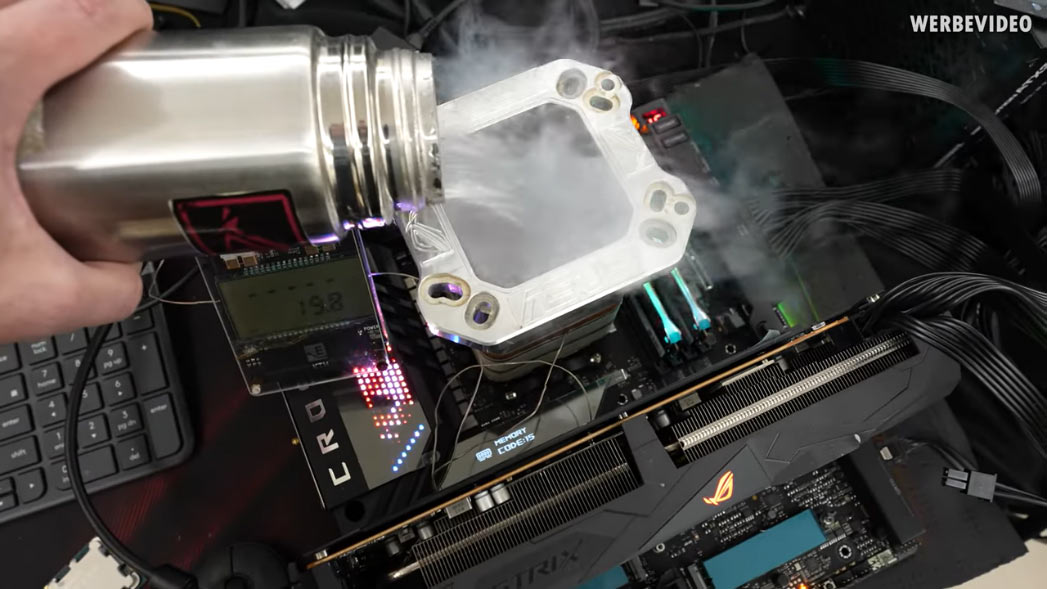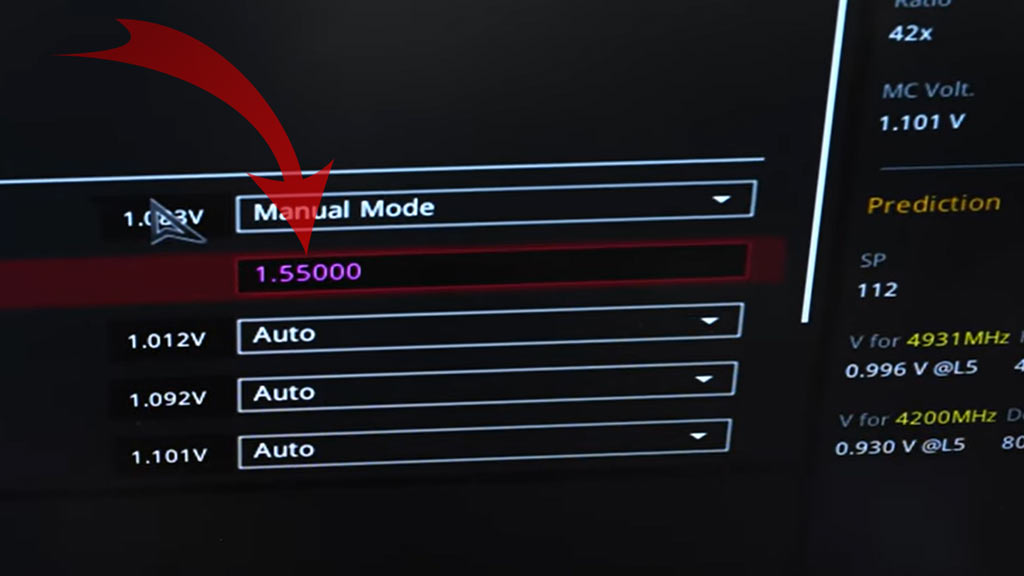Ryzen 7000X3D May Be Limited to 1.35V After Der8auer's CPU Catastrophe
1.55V was too much. So 1.35V will likely be the new limit for tweaking these X3D chips.
Famous overclocker der8auer visited Asus HQ this week and killed a shiny new AMD Ryzen 7000X3D with alarming ease. The 3D V-Cache enhanced Ryzen 9 7950X3D didn’t last long in overclocking tests, after tweaked voltages and lashings of liquid nitrogen cooling were applied. However, the untimely death of this CPU will ultimately save others, as Asus / AMD will “probably” implement a 1.35V ceiling on X3D processors in upcoming motherboard BIOS updates.
Der8auer is currently documenting a trip to Taiwan via YouTube. After quaffing a pint of the local bubble tea, he headed to Asus HQ for some computer testing and overclocking fun. The TechTuber explained it had been around seven years since his last visit to the tech treasure island, mainly because of the Covid-19 pandemic and travel restrictions.
After several days of Intel Sapphire Rapids testing, Der8auer was offered the opportunity to test the latest AMD Ryzen 7000X3D processors at Asus’ well-equipped labs. The expert overclocker had a feeling that there could be a “great risk” in undertaking such an endeavor, due to AMD’s warnings and locking down of the previous gen X3D parts (AMD Ryzen 5000X3D processors). However, with the latest gen, AMD has relaxed things a little, allowing more tweakability for those who like to dabble.
Using a Ryzen 9 7950X3D and Asus ROG Crosshair X670E Extreme, der8auer began his investigations into performance and power. At the start of this section of the video, the overclocker says that the CPU typically ran at 1V, but the Crosshair motherboard allowed him to pump up the voltage to 1.35V, as a modest but worthwhile first step in LN2-fuelled overclocking. The observed temperatures of <90°C with liquid nitrogen cooling were comfortably near to what would be expected at stock voltages using an AiO liquid cooler.
Encouraged by the success of the overvolting and stability of the system, der8auer decided on a next step of 1.55V. He explained that this kind of voltage was a significant ramp up from stock, but would be a typical next step in exploring the capabilities of a modern Intel CPU or AMD CPU without 3D V-Cache.
Upon restart, right after the BIOS screen flew past, the open bench testing system fell flat, with the motherboard showing an ominous 00 error code. The usual means of error recovery didn’t revive this system, and subsequent investigations revealed that the CPU was stone dead. Der8auer’s video voiceover asserts that the demise of the CPU was entirely unexpected, especially as it only managed to run past the BIOS screen, and no testing or computational load was exerted using the new voltage.

The YouTuber didn’t want to draw conclusions about safe voltages for the Ryzen 7000X3D series based on a sample of one, but reported back to Asus, who will probably limit the max manual selectable voltage for X3D chips to 1.35V. He surmised that the voltage being so configurable, and options up to 2.5V being available, was probably an oversight by AMD motherboard partners and needed to be fixed.
Get Tom's Hardware's best news and in-depth reviews, straight to your inbox.
Elsewhere in der8auer’s video, you can watch some Sapphire Rapids OC fun, look at some overclocking hardware prototypes, and more. The 35-minute video is well worth a watch. You can enjoy the full video above.

Mark Tyson is a news editor at Tom's Hardware. He enjoys covering the full breadth of PC tech; from business and semiconductor design to products approaching the edge of reason.
-
bit_user Why didn't he bring with him a spare CPU? Even if he had to go out an buy one, I'm pretty sure he'd have been able to find one.Reply -
georgebaker437 Although I generally respect this YouTuber's opinions and methodology, 1.35 directly to 1.55 seems a bit cavalier. Perhaps 1.4 to 1.45 to 1.5 might have been the proper sequence. Then again, it was someone else's CPU!Reply -
helper800 Reply
A 15% jump in voltage after a 35% jump in voltage certainly seems like a bad idea given the circumstances... I would just assume he didn't care much because it was not his CPU.drivinfast247 said:1.35v to 1.55 is quite the jump IMO -
rluker5 Seeing over 1.35v in transients is common with modern chips. 1.55 isn't a crazy voltage either. Just more than you can cool, but ln2 fixes that.Reply
Maybe the cache broke off because of the huge thermal gradient. -
doughillman ReplyGiroro said:If this guy were any good, he wouldn't be on YouTube.
This is both a bad, and seemingly unknowledgeable take. He's one of the most highly respected guys in the industry. -
DavidLejdar Reply
To be fair, his activity goes beyond that. E.g. the company Thermal Grizzly has been working with him in the development of thermal pastes, and the company Alpenföhn has been working with him in regard to cooling solutions - such as in regard to the AiO Gletscherwasser (280 or 360). And then there is also some collaboration with the retailer Caseking, where one can get among other custom built rigs such as this one:zecoeco said:Apparently, Tom's sponsoring for this YouTuber.
I hope I'm wrong tho.
And such products may not be on par with the big players on the international market, in particular in regard to availability. But aside from his renown as overclocker, it arguably puts him in the scope of such "business news" as well.
To be clear, his name has no relevance for me when picking components. But as I have Caseking pretty much around the corner here in Berlin, I went through the listings of components they have there, and then ended up with an Alpenföhn AM5 CPU cooler - which is why I know a bit about it. -
Udyr Although it was pointed out that a sample of one is not enough for a conclusion, the article itself with the title, the wording and the pretending to be funny image, leads to imply these CPUs are bad for overclocking.Reply
Instead of an article, this looks more like a low blow to AMD.


